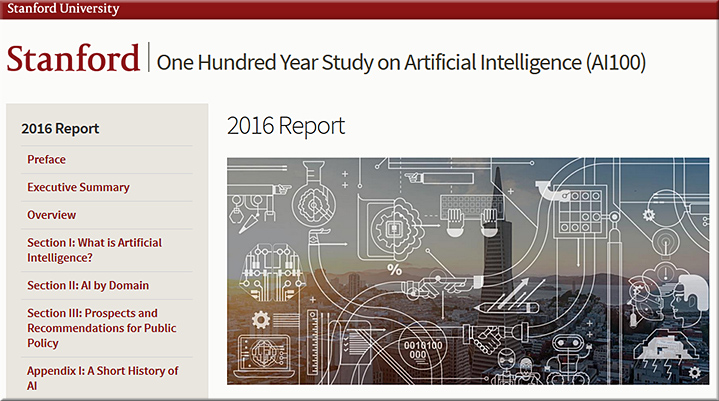Stanford | One Hundred Year Study on Artificial Intelligence (AI100)
Executive Summary
Artificial Intelligence (AI) is a science and a set of computational technologies that are inspired by—but typically operate quite differently from—the ways people use their nervous systems and bodies to sense, learn, reason, and take action. While the rate of progress in AI has been patchy and unpredictable, there have been significant advances since the field’s inception sixty years ago. Once a mostly academic area of study, twenty-first century AI enables a constellation of mainstream technologies that are having a substantial impact on everyday lives. Computer vision and AI planning, for example, drive the video games that are now a bigger entertainment industry than Hollywood. Deep learning, a form of machine learning based on layered representations of variables referred to as neural networks, has made speech-understanding practical on our phones and in our kitchens, and its algorithms can be applied widely to an array of applications that rely on pattern recognition. Natural Language Processing (NLP) and knowledge representation and reasoning have enabled a machine to beat the Jeopardy champion and are bringing new power to Web searches.
While impressive, these technologies are highly tailored to particular tasks. Each application typically requires years of specialized research and careful, unique construction. In similarly targeted applications, substantial increases in the future uses of AI technologies, including more self-driving cars, healthcare diagnostics and targeted treatments, and physical assistance for elder care can be expected. AI and robotics will also be applied across the globe in industries struggling to attract younger workers, such as agriculture, food processing, fulfillment centers, and factories. They will facilitate delivery of online purchases through flying drones, self-driving trucks, or robots that can get up the stairs to the front door.
This report is the first in a series to be issued at regular intervals as a part of the One Hundred Year Study on Artificial Intelligence (AI100). Starting from a charge given by the AI100 Standing Committee to consider the likely influences of AI in a typical North American city by the year 2030, the 2015 Study Panel, comprising experts in AI and other relevant areas focused their attention on eight domains they considered most salient: transportation; service robots; healthcare; education; low-resource communities; public safety and security; employment and workplace; and entertainment. In each of these domains, the report both reflects on progress in the past fifteen years and anticipates developments in the coming fifteen years. Though drawing from a common source of research, each domain reflects different AI influences and challenges, such as the difficulty of creating safe and reliable hardware (transportation and service robots), the difficulty of smoothly interacting with human experts (healthcare and education), the challenge of gaining public trust (low-resource communities and public safety and security), the challenge of overcoming fears of marginalizing humans (employment and workplace), and the social and societal risk of diminishing interpersonal interactions (entertainment). The report begins with a reflection on what constitutes Artificial Intelligence, and concludes with recommendations concerning AI-related policy. These recommendations include accruing technical expertise about AI in government and devoting more resources—and removing impediments—to research on the fairness, security, privacy, and societal impacts of AI systems.
Contrary to the more fantastic predictions for AI in the popular press, the Study Panel found no cause for concern that AI is an imminent threat to humankind. No machines with self-sustaining long-term goals and intent have been developed, nor are they likely to be developed in the near future. Instead, increasingly useful applications of AI, with potentially profound positive impacts on our society and economy are likely to emerge between now and 2030, the period this report considers. At the same time, many of these developments will spur disruptions in how human labor is augmented or replaced by AI, creating new challenges for the economy and society more broadly. Application design and policy decisions made in the near term are likely to have long-lasting influences on the nature and directions of such developments, making it important for AI researchers, developers, social scientists, and policymakers to balance the imperative to innovate with mechanisms to ensure that AI’s economic and social benefits are broadly shared across society. If society approaches these technologies primarily with fear and suspicion, missteps that slow AI’s development or drive it underground will result, impeding important work on ensuring the safety and reliability of AI technologies. On the other hand, if society approaches AI with a more open mind, the technologies emerging from the field could profoundly transform society for the better in the coming decades.
From DSC:
I’m a bit more cautious and skeptical on the potential uses of AI than this panel. Though there will likely be many positive impacts of AI on society, I see plenty in our world that drives my skepticism (one such example is the use of AI and robotics that are being leveraged/developed by the large military operations of the world).










I have invented algorithms for artificial general intelligence that make it possible to build truly intelligent robots.
My robots can learn, see, move and behave exatly like humans.
No more research is needed.
I guess you will be skeptical at Stanford but don’t be.
Would you be about Edison too?
Let’s face it, big things are not being invented at universities.
I am looking for US company to build first intelligent robots.
Go to http://www.moravcik.info